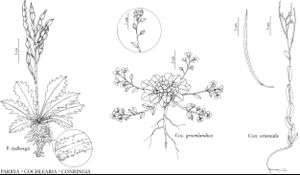Parrya
Chlor. Melvill., 10, plate B. 1823.
| Taxon | Illustrator ⠉ | |
|---|---|---|
 | Parrya rydbergii Cochlearia groenlandica Conringia orientalis | Yevonn Wilson-Ramsey Yevonn Wilson-Ramsey Yevonn Wilson-Ramsey |
Perennials [subshrubs]; (caudex well-developed, often covered with persistent petiolar remains or leaves); scapose [not scapose]; glandular or eglandular, glabrous [pubescent]. Stems erect, unbranched. Leaves basal [sometimes cauline]; rosulate; petiolate; blade margins entire, subentire, or dentate [pinnately lobed]. Racemes (corymbose, 3–20-flowered, rarely proximalmost flowers bracteate), considerably elongated in fruit. Fruiting pedicels ascending or divaricate-ascending [erect]. Flowers: sepals ovate or oblong [linear], (unequal, glandular or eglandular); petals purple, lavender, or white [pink], obovate, claw differentiated from blade, (subequaling or longer than sepals, apex rounded or emarginate); stamens tetradynamous; filaments dilated or not basally; anthers oblong [linear], (apex obtuse); nectar glands lateral, annular or semiannular. Fruits sessile or shortly stipitate (gynophore persistently attached to pedicel), not segmented, linear, oblong, or lanceolate, smooth or torulose, strongly latiseptate or, rarely, subterete or 4-angled; valves (leathery), each with prominent midvein and with obscure to distinct lateral and marginal veins, eglandular or glandular; replum almost always flattened (visible); septum complete; ovules 6–20 [–50] per ovary; stigma conical or cylindric, 2-lobed (lobes prominent, connate, decurrent). Seeds often broadly winged, suborbicular to broadly ovate [oblong], strongly flattened; seed-coat (smooth), not mucilaginous when wetted; cotyledons accumbent. x = 7.
Distribution
North America, Asia (w China), Asia (Himalayas), Asia (Russian Far East), Asia (Siberia)
Discussion
Species 25–30 (4 in the flora).
Parrya is a distinctive genus reduced by V. P. Botschantzev (1972) to being monospecific, including only P. arctica, with almost all of the other species transferred to Neuroloma. Except for the four North American species, the genus is centered in central Asia, adjacent western China, and the Himalayas.
Selected References
Lower Taxa
Key
| 1 | Sepals 2.5-3.5 mm; petals 6-7 mm, apex rounded; ovules 6-8 per ovary; fruits obovate to oblong, 0.8-1.4(-1.7) cm. | Parrya nauruaq |
| 1 | Sepals (3-)4-9 mm; petals (8-)10-23 mm, apex emarginate; ovules 10-20 per ovary; fruits narrowly oblong to linear-lanceolate, (1-)1.5-5 cm | > 2 |
| 2 | Plants eglandular; leaf blades linear-oblanceolate to narrowly oblanceolate, 2-5(-7) mm wide; sepals (3-)4-5 mm; petals (8-)10-13 × 3-5 mm, claws 3.5-4.5 mm; ovules 14-20 per ovary. | Parrya arctica |
| 2 | Plants glandular or eglandular; leaf blades obovate, spatulate, broadly oblanceolate, lanceolate, or oblong, (6-)10-28 mm wide; sepals 5-9 mm; petals (14-)16-23 × 7-12 mm, claws 6-12 mm; ovules 10-16 per ovary | > 3 |
| 3 | Plants glandular or eglandular, not cespitose; leaf blade margins entire, minutely to coarsely dentate, or, rarely, incised; fruiting pedicels (10-)15-40(-60) mm; filaments 6-10 mm; Alaska, British Columbia, Northwest Territories, Yukon. | Parrya nudicaulis |
| 3 | Plants usually densely glandular, rarely eglandular, densely cespitose; leaf blade margins incised to coarsely dentate; fruiting pedicels 4-15(-20) mm; filaments 4-6 mm; Utah, Wyoming. | Parrya rydbergii |
"elongated" is not a number."thick" is not a number.